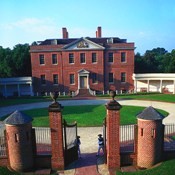With some 500 miles of shoreline and barrier islands running the length of North Carolina and South Carolina, water is an integral part of the agenda when gathering in the coastal destinations of either state.
Planners have countless options at their fingertips, whether it’s sailing, surfing and diving in the Atlantic, kayaking along the shallow sounds, stopping at a white-sand beach for a quick dip in the ocean, or holding a get-together overlooking the water.
SOUTH CAROLINA
Myrtle Beach
Long known as the hub of the Grand Strand, a 60-mile stretch of wide, sandy beaches, Myrtle Beach enjoys year-round warm temperatures.
To get attendees on the water, Danna Lilly, director of sales at the Myrtle Beach Area CVB, recommends charter fishing, ocean adventure cruises and waterway excursions.
Fishing enthusiasts can choose among eight fishing piers and backwater creeks between Georgetown and Little River. These creeks are also great for crabbing.
Sea Note Sport Fishing Charters is a charter sport and saltwater fishing service located in Murrells Inlet, 10 miles south of Myrtle Beach. The company caters to small groups, providing guides, licenses, and bait and tackle.
Lilly says smaller groups can also try parasailing, banana boat rides, jet skiing, pier fishing, and boating, among other diversions.
“Also, many resorts offer team-building activities that include an option for beach olympics,” she says.
Water is never too far away in Myrtle Beach, even during business hours.
“We’re excited that the Myrtle Beach area will have a new conference facility opening in the spring of 2008 at Barefoot Resort,” Lilly says. “It’s a Premier Resorts property located along the Intracoastal Waterway in North Myrtle Beach.”
The adjacent freshwater marina offers 142 premium boat slips available for rent and docks for overnight docking guests.
Attendees can schedule jet ski tours and boat rentals here to have some fun at the end of their meeting day.
Charleston and the Resort Islands
One of the biggest selling points for the Charleston region, comprising Charleston and nearby Kiawah Island, Seabrook Island and Isle of Palms, is that beach weather starts in March or April and lasts through October, according to Suzanne Wallace, director of sales for the Charleston Area CVB.
“You may not be in your bathing suit and in the sun, but you’re in shorts enjoying the outdoors,” she says. “Some attendees have never seen the beach before, and most meeting planners find that whenever they plan a meeting here, they have more [attendees] because people will bring their family.”
To savor the coastal breeze aboard a ship, Wallace suggests scheduling a dinner cruise.
“About nine out of 10 meeting planner will choose a dinner cruise,” Wallace explains. “You can have a band and a four-course dinner. The pirate-themed cruises are also very popular.”
For small groups, Wallace suggests the three-masted Schooner Pride. Attendees cruise through the historic Charleston Harbor, where the infamous English pirate known as Blackbeard once attacked local sailors.
Another popular choice is SpiritLine Charters, a company that organizes dinners and receptions for groups of from 20 to more than 400 on four different boats.
From March until November, Sandlapper Tours takes up to 49 passengers on its 45-foot catamaran. During the cruise around the harbor, groups listen to tales of haunted forts and tragic deaths of pirates such as Stede Bonnet, who plundered alongside Blackbeard and was hanged in 1718.
Fort Sumter tours are a hit with history buffs. Boat tours will accommodate up to 300 people. Located in the center of the harbor, the island is where the first shots of the Civil War were fired. A Confederate bastion, Fort Sumter was attacked by Union forces from 1863 to 1865.
For a water-themed reception, the South Carolina Aquarium is a very popular venue. The aquarium is available after-hours for private functions, and planners can install food stations throughout the building and have the staff talk about the thousands of aquatic animals in the aquarium, from sharks and loggerhead turtles to river otters.
Hilton Head Island
Approximately 90 miles south of Charleston is serene Hilton Head Island. The 12-mile-long and five-mile-wide island was one of the first eco-planned destinations in the U.S. It enjoys salt marshes, lagoons and creeks, forests full of moss-covered oaks, pines and palmettos, and 12 miles of sandy beaches.
“Many people don’t know that Hilton Head is a natural dolphin habitat, so visitors may see dolphins when they go out on a boat tour,” says Charlie Clark, vice president of communications for the Hilton Head Island–Bluffton Chamber of Commerce.
For groups of up to 50 people looking to get on the water, Jack Reed, director of sales for the Hilton Head Island–Bluffton Visitors and Convention Bureau, recommends the new tour spotlighting celebrity chef Paula Deen. The tour leaves from River Street in the historic part of town and takes groups on a cruise to nearby Savannah, Ga.
“It stops for lunch at The Lady & Sons restaurant in Savannah,” Clark says. “It’s not easy to get a reservation there, so to be able to get a reservation as a part of the tour is really great for groups.”
Canoeing and kayaking are great ways for attendees to explore the island’s creeks, marshes and inlets along Calibogue Sound. A local adventure tour company, Outside Hilton Head, offers a year-round kayaking school, in addition to kayak and boat tours, and team-building and leadership programs that incorporate waterborne activities. Groups can also go on guided tours and day and overnight trips to destinations such as Cumberland and Pritchards islands.
“We had a meeting recently, and we took a group on lagoon kayaks and they loved it,” Reed says.
He also suggests a cruise aboard Stars & Stripes, the 12-meter yacht that competed in the America’s Cup.
NORTH CAROLINA
Outer Banks
The Outer Banks, a 100-mile-long string of narrow barrier islands, runs along approximately half of the northern North Carolina coastline.
A major tourist destination, the area is known for temperate weather and wide-open shoreline. It was here in 1903, at Kill Devil Hills, that the Wright Brothers took their first flight.
“When we think of the Outer Banks, we should think in terms of wind activity and water activity,” says Carolyn McCormick, managing director of the Outer Banks Visitors Bureau.
According to McCormick, kite boarding has become a very popular activity for anyone visiting the Outer Banks. Mixing wind and water, a kite boarder is strapped by foot to a board with a giant kite attached to it, enabling the rider to glide on water and into the air by maneuvering the kite with the wind. With Kitty Hawk Kites, a favorite option in the area, groups can go out for a short morning lesson and be surfing on the water and catching some air in the afternoon.
“Seasoned kite boarders can jump and things like that, but the great thing with kite boarding is that really anybody can do it,” McCormick explains.
Meeting planners should also consider the many ways to simply enjoy the water views, according to McCormick. Recently the National Tour Association met here and she took them on a small plane ride.
“They got a kick out of seeing the fragile little chain of islands from up there,” McCormick says, adding that the Outer Banks are a great place for small groups and board meetings because it’s so isolated. “Everywhere you look here, there’s water.”
For groups of up to 12 people, kayaking is an ideal means of exploring the waterways and salt marshes. Groups can also kayak to historic Roanoke Island, where English ships led by John White arrived in 1587. All it takes is a quick lesson on how to paddle and attendees can be out on the water.
“Whether you’ve never done it or done it before, kayaking is a piece of cake,” McCormick says. “The sound is so shallow that even if you did tip over, you’re not going to go too far. Anybody at any age can do it.”
Crystal Coast
Also known as the Southern Outer Banks, the Crystal Coast is an 85-mile stretch of waterfront that extends from the Cape Lookout National Seashore, which includes 56 miles of protected beaches, southwestward to the New River.
“The appeal of the area is its pristine beaches, historic charm, wild horses that roam our islands freely, and exceptional restaurants and caterers that can whip up a clam bake or “shrimp-a-roo” for 10 to 1,000,” says Carol Lohr, executive director of the Crystal Coast Tourism Authority.
In addition to adventures above the water, the area is home to a hidden graveyard of more than 2,000 sunken ships—some sunk by sailors who wanted to avoid being captured. Others were attacked by German U-boats during World War II.
Thanks to Dive Down, a program recently implemented by the state, a limited number of recreational divers can now check out the remains of the historic Queen Anne’s Revenge, Blackbeard’s flagship. Legend has it that in 1718 Blackbeard decided to ground the ship and leave with only a few of his crew. Since its discovery, the shipwreck had only been open to archeologists and state officials in order to ensure its protection.
Lohr also recommends sailing charters on the 41-foot Good Fortune, captained by a biologist who takes groups out on ecology tours of the Crystal Coast.
New Bern and Craven County
Located at the convergence of the Trent and the Neuse rivers, Craven County is a resort destination with a restored downtown that offers waterfront hotels, bed and breakfast properties and inns.
According to Sandy Chamberlin, director of the New Bern/Craven County CVB, a water taxi service from the New Bern Riverfront Convention Center to the Bridgepoint Hotel and Marina is available for groups.
“The water taxi has been a big hit and will often show guests a bit of the town via the rivers as time permits,” she says.
Also available is a 150-passenger charter boat for banquets, receptions with entertainment and general river tours as well as canoeing, kayaking and other watercraft rentals on both the Trent and Neuse rivers.
Wilmington and the Cape Fear Coast
From its 31 miles of white-sand island beaches to the shores of the Cape Fear River, the Wilmington and Cape Fear Coast area has plenty of water activities on hand.
Mikie Wall, vice president of sales and services at the Wilmington/Cape Fear Coast CVB, recommends boat outings with companies such as Wrightsville Beach Scenic Cruises & Water Taxi. Owned and operated by Joe Abbate, a local naturalist, the firm takes groups on fishing excursions and nature cruises.
Cape Fear Divers, a new scuba diving company based in Carolina Beach, offers groups several dive site options, including wrecks, reefs and ledges with abundant marine life. Groups can choose to do deep or shallow dives, and adventurous travelers can also try a shark dive.
“Our destination also offers quality oceanfront and riverside meetings hotels, and unique off-site meeting facilities such as the Battleship North Carolina,” Wall says.
For corporate team-building programs, the area has a lot to offer. The Wrightsville Beach Surf Camp organizes overnight and day surf camps that teach the basics of the sport.
Wall also recommends programs offered by the Atlantic Quest Corporation.
“They have half-day and all-day catered team-building events that take groups out to Masonboro Island, an undeveloped estuarine research reserve for outdoor activities that promote team building,” Wall says.
For More Info
NORTH CAROLINA
Crystal Coast Tourism Authority 252.726.8148
www.sunnync.com
New Bern/Craven County CVB 252.637.9400
www.visitnewbern.com
Outer Banks Visitors Bureau 252.473.2138
www.outerbanks.org
Wilmington/Cape Fear Coast CVB 910.341.4030
www.cape-fear.nc.us
SOUTH CAROLINA
Charleston Area CVB 843.853.8000
www.charlestoncvb.com
Hilton Head Island–Bluffton COC and VCB 843.785.3673
www.hiltonheadisland.org
Myrtle Beach Area CVB 843.626.7444
www.myrtlebeachinfo.com






